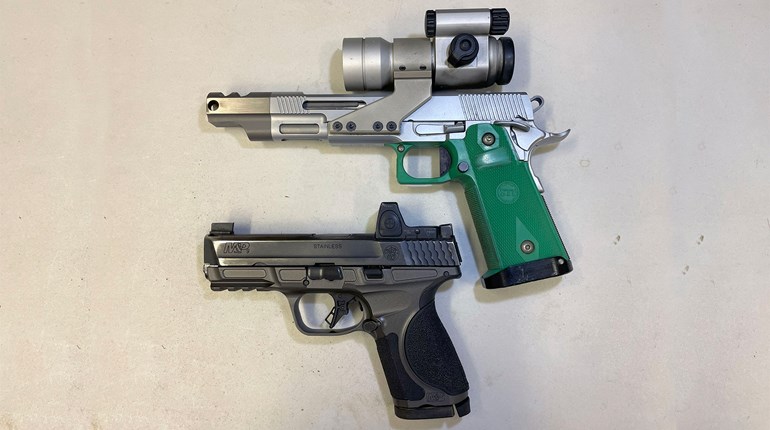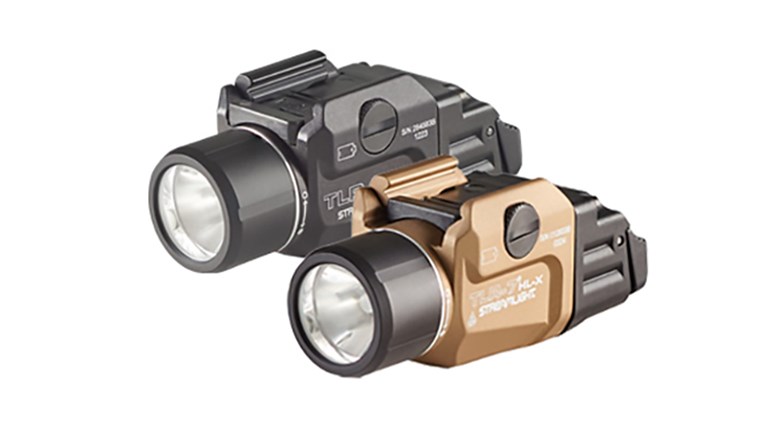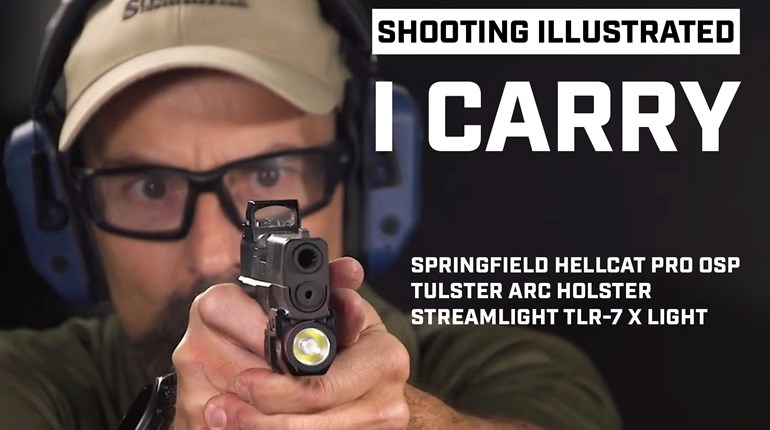
We all have five senses, but one of them is more important than the others when defending against criminal attacks. Sight, or vision, is the critical sense most often used to identify a deadly threat, and it plays an obvious role in effectively stopping an attack with accurate gunfire. You simply cannot, and should not, shoot something you cannot see.
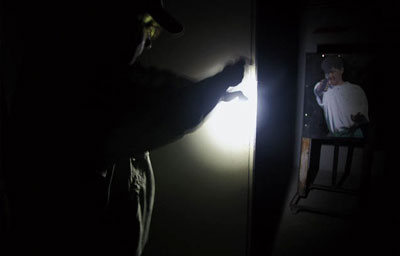
When using a firearm to defend your life or that of another, proper identification of the threat is vital. Away from the gun range, there are far more things that should not be shot than things that should. Responsible citizens understand they will be held accountable for every round they fire. If any of these negligently strikes something or someone, the person who fired that shot is liable. Gaining an awareness of not only a threat, but also what is behind, in front of or beside it—and reacting appropriately—requires sight.
Unfortunately, violent crime and assaults occur predominantly during the hours of darkness or in places with diminished light when vision is compromised. The FBI Uniform Crime Reports are compiled annually, and year after year they show police officers are attacked and killed during low-light hours between 60 and 70 percent of the time. Other life-threatening criminal activities, like home invasions and muggings, follow the same pattern.
Compounding the problem is the deterioration of vision brought on by age. As we age, our eyes require more light to function normally. It's a simple fact of growing older. In dim light, the eyes of a 40-year-old will not see as clearly as those of someone in his 20s. Older eyes may need three to four times more light to function as they did when they were younger. Vision issues include a reduced ability to see contrast and colors and impaired depth perception. The amount of time it takes for the eyes to transition from light to dark or vice versa increases with age as well.
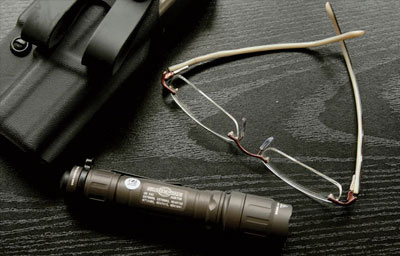
Corrective lenses certainly help with vision problems, but consider the following scenario: It's 2 a.m. and you spring up in bed in a panic. Your Lab is barking ferociously, and you thought you heard a crash down the hall. The adrenaline is racing as your grab a pistol and flashlight from the nightstand. Your children are asleep in their bedrooms, and their safety is at the forefront of your mind.
How many of you think you'll remember to grab your prescription glasses?
Let's say you have the clarity of mind to reach for your glasses, but in the haste of the moment you can't find them. Or maybe you do find them, but they're knocked off in a struggle with the intruder. Can you shoot your defensive gun without your prescription glasses? More importantly, can you identify the threat using a flashlight? Can you hit your target?
Right Light
The best tool available to help make up for the aforementioned vision deficiencies is white light—and lots of it. When we find ourselves in poor light conditions, handicapped by aging eyes or absent glasses, it's time to pour on the white light.
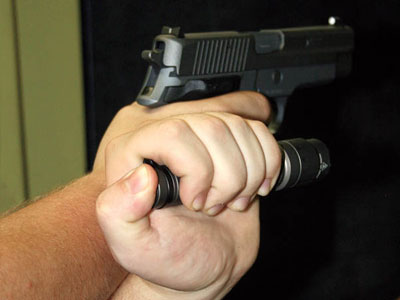
How bright should the light be? Generally speaking, the more light the better.
An accurate way to gauge "brightness" is by expressing it in lumens, which measure the entire output of visible light. You may have also heard of candlepower, which measures the brightest part of the beam, but lumens give a better representation of the total amount of available light. Sixty- to 100-lumen flashlights are good, but those producing 200 lumens are far superior. A light small enough to be carried in a pocket with an output of 100-plus lumens should get you through the night.
There are two basic types of lights that will best serve you in a defensive situation: hand-held and weapon-mounted. Pros and cons come with each, and one isn't necessarily better or worse than the other.
Both require practice to use effectively in concert with a firearm. Regardless of the deployment system, quality tactical or combat lights should have certain characteristics.
They should produce a solid, focused beam of unbroken light. Cheap flashlights, usually of foreign manufacture, have "dead spots," or dim areas, in the beam due to poorly constructed reflectors. These are nothing more than throw-away lights. I'm sure you'll agree your life is worth more than a $5 flashlight. Consider models built specifically for self-defense or duty use from respected manufac-turers such as SureFire, Streamlight and Blackhawk.
White LED lights are the rage and provide many benefits. LEDs have no bulb filaments to break, and they offer tremendous battery life and runtime. For hand-held tactical lights, the switch should be some form of pushbutton at the base of the light. This allows you to find it easily in complete darkness with either hand. Dual switching between momentary- and constant-on is a plus. For personal protection, stay away from lights with beams having an adjustable focus.
Weapon-mounted lights, whether on handguns, rifles or shotguns, must be rated as such from the maker and be shock-resistant. Just because a light uses an LED instead of an incandescent bulb doesn't mean it's a good weaponlight. The shock from a recoiling firearm can jar loose cheap wiring and circuits. Again, it pays to purchase a brand-name weapon-mounted light from a maker known for quality.
Laser Aid
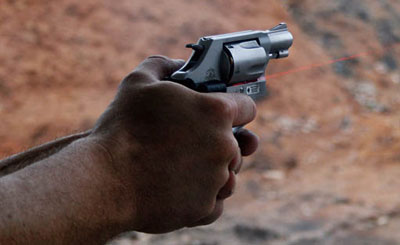
Low-light conditions not only make it difficult to identify a threat, but they also complicate aiming. If you can't see your front sight, it's tough to deliver accurate shots beyond a couple of yards. A weapon-mounted laser will not illuminate a threat or your surroundings, but it can provide a definitive, highly visible aiming point in light conditions that make it difficult to see conventional sights.
Crimson Trace Lasergrips, which replace the grip panels or wrap around the grip area of pistols and revolvers, are known for their easy activation. Hold the handgun in a firing grip, and the middle finger of your strong hand activates the laser. LaserLyte offers a replacement rear sight for several handguns that incorporates a tiny laser module. Other manufacturers like LaserMax and Viridan produce rail-mounted lasers. LaserMax also makes guide rods with an integral laser for a number of pistols. Most of these companies offer lasers for long guns as well, either as compact units or vertical foregrips that attach to an accessory rail.
Regardless of what type of laser you choose, activating it should be simple and straightforward, and you should practice until operation becomes second nature. And, of course, you need to zero the laser after mounting or installing it.
Lasers help overcome another issue when shooting in low light. There is a strong tendency to want to shoot the light beam. That is, when using a hand-held flashlight, you may inadvertently shoot toward the brightest part of the light, which may not be illuminating the target's vital area. Even though you know you should be shooting at the upper torso, your mind and eyes are drawn to the brightest area, and that's where you will hit.
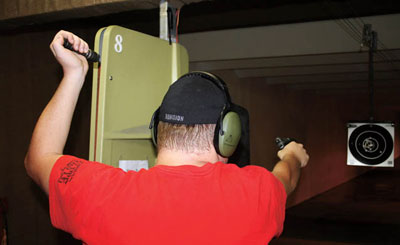
By introducing a visible laser sight, be it red or green, the desire to shoot the light versus the appropriate part of the target is lessened tremendously. The subconscious desire to shoot toward the beam of the flashlight seems to be overcome by the presence of an intense aiming point.
Sights to See
Absent a visible laser, the next best thing is to have iron sights that you can actually see in the dark. A tritium insert in the front sight helps a great deal. Remember, the front sight is the most important one. If you have more light-emitting material in the rear sight than the front, it defeats the purpose.
Minus tritium, the front sight of your defensive firearm should reflect what ambient light is available. Gold beads, fiber-optic inserts and even white paint are better alternatives than a plain black front sight. Whatever the design, the front sight should stand out from the rest of the gun, not blend in with it. The Big Dot and Standard Dot front sights from XS Sight Systems are excellent examples.
There are a host of sights made for low-light conditions available from manufacturers such as Trijicon, Novak's, Meprolight, TruGlo and XS Sight Systems that fit most pistols and a number of revolvers. If your defensive handgun isn't so equipped, swapping sights is a simple job for a qualified gunsmith with the appropriate tools. Some companies like Trijicon and Novak's will also install their sights on a firearm for a nominal fee.
Night Training
Shooting accurately in low-light conditions while using lights and lasers is an advanced skill and must be practiced if you have any hope of doing it under stress. The twisted irony is that the vast majority of firearm training is conducted when the light is best. Most ranges are closed during foul weather and at night. Nearly all public and private ranges have strict rules about shooting after sunset, and few police departments train in darkness. For those that do, it is normally for annual qualification and not a regular event. If you are serious about defending your life with a firearm, seek out realistic training and find a school that conducts low-light training.
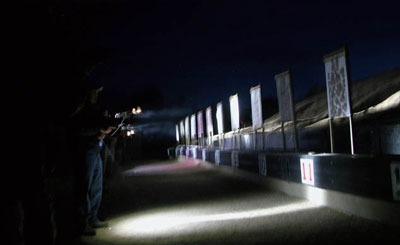
When you can't shoot at night, take your firearm with a flashlight or a weapon-mounted light to the daytime range. Use the light to "illuminate" the target, and run through some drills. You will soon know whether the gun and light will operate in conjunction with each other. The same is true with a laser. Practice activating it while you present or shoulder your firearm. Most lasers, particularly green ones, are visible in daylight against light-colored targets at close ranges. However, the culmination of your learning should take place in actual darkness on a live-fire range.
There are several professional firearms schools that offer advanced self-defense courses where students engage targets in the dark. During a recent trip to Gunsite Academy, I took part in nighttime training using both indoor and outdoor simulators.
During the indoor exercise, I ran the scenario with clear safety glasses, but without my prescription set. My pistol had a SureFire X300 weaponlight. It was a challenge, as there were both "shoot" and "no-shoot" full-color targets in the specially designed building. If all you have ever practiced is slow-fire shooting on a square range in ample light, clearing a building in the dark with a flashlight is an eye-opening experience. Any person serious about protecting their loved ones with firearms should seriously consider such training. It's not easy and it's not cheap, but it's worth every penny.
Outdoors, I took a trip through Gunsite's West Wash, which is populated with steel popper targets hidden in cutouts and obscured by dirt berms. Students must work a serpentine drill, slicing the pie left and right. I used a Colt M4 carbine fitted with a Crimson Trace MVF-515 foregrip, which incorporates both a visible laser (red or green) and a white LED light. Pressure pads activate the light, laser or both. The particular model I used was equipped with a brilliant green laser.
Working with only starlight and the illumination provided by the MVF-515, I engaged reactive steel targets from 5 to 15 yards using frangible ammunition. At the end of the drill I was exhilarated. It seemed it wasn't even fair for the targets. The combination worked tremendously well and demonstrated the benefits of having a white light and a laser on a long gun for nighttime situations.
When it comes to personal-protection scenarios, having a gun is good. Having a gun and a light is even better. The gun-light-laser combination would be the best of all. But tools without training are merely toys. Arm yourself with the best training and equipment available for dealing with threats in low light. Combining the two will give you the skill and confidence you'll need when faced with things that go bump in the night.












